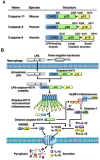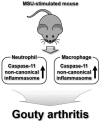Roles of the Caspase-11 Non-Canonical Inflammasome in Rheumatic Diseases
- PMID: 38396768
- PMCID: PMC10888639
- DOI: 10.3390/ijms25042091
Roles of the Caspase-11 Non-Canonical Inflammasome in Rheumatic Diseases
Abstract
Inflammasomes are intracellular multiprotein complexes that activate inflammatory signaling pathways. Inflammasomes comprise two major classes: canonical inflammasomes, which were discovered first and are activated in response to a variety of pathogen-associated molecular patterns (PAMPs) and danger-associated molecular patterns (DAMPs), and non-canonical inflammasomes, which were discovered recently and are only activated in response to intracellular lipopolysaccharide (LPS). Although a larger number of studies have successfully demonstrated that canonical inflammasomes, particularly the NLRP3 inflammasome, play roles in various rheumatic diseases, including rheumatoid arthritis (RA), infectious arthritis (IR), gouty arthritis (GA), osteoarthritis (OA), systemic lupus erythematosus (SLE), psoriatic arthritis (PA), ankylosing spondylitis (AS), and Sjögren's syndrome (SjS), the regulatory roles of non-canonical inflammasomes, such as mouse caspase-11 and human caspase-4 non-canonical inflammasomes, in these diseases are still largely unknown. Interestingly, an increasing number of studies have reported possible roles for non-canonical inflammasomes in the pathogenesis of various mouse models of rheumatic disease. This review comprehensively summarizes and discusses recent emerging studies demonstrating the regulatory roles of non-canonical inflammasomes, particularly focusing on the caspase-11 non-canonical inflammasome, in the pathogenesis and progression of various types of rheumatic diseases and provides new insights into strategies for developing potential therapeutics to prevent and treat rheumatic diseases as well as associated diseases by targeting non-canonical inflammasomes.
Keywords: caspase-11; caspase-4; inflammasome; non-canonical inflammasome; rheumatic disease.
Conflict of interest statement
The author declares no conflicts of interest.
Figures






Similar articles
-
Regulatory Roles of Caspase-11 Non-Canonical Inflammasome in Inflammatory Liver Diseases.Int J Mol Sci. 2022 Apr 30;23(9):4986. doi: 10.3390/ijms23094986. Int J Mol Sci. 2022. PMID: 35563377 Free PMC article. Review.
-
The role of NLRP3 inflammasome in the pathogenesis of rheumatic disease.Autoimmunity. 2022 Feb;55(1):1-7. doi: 10.1080/08916934.2021.1995860. Epub 2021 Oct 29. Autoimmunity. 2022. PMID: 34713773 Review.
-
Functional crosstalk between non-canonical caspase-11 and canonical NLRP3 inflammasomes during infection-mediated inflammation.Immunology. 2020 Feb;159(2):142-155. doi: 10.1111/imm.13134. Epub 2019 Nov 10. Immunology. 2020. PMID: 31630388 Free PMC article. Review.
-
Non-Canonical Inflammasome Pathway: The Role of Cell Death and Inflammation in Ehrlichiosis.Cells. 2023 Nov 9;12(22):2597. doi: 10.3390/cells12222597. Cells. 2023. PMID: 37998332 Free PMC article. Review.
-
Caspase-11 Noncanonical Inflammasome: A Novel Key Player in Murine Models of Neuroinflammation and Multiple Sclerosis.Neuroimmunomodulation. 2021;28(4):195-203. doi: 10.1159/000516064. Epub 2021 May 27. Neuroimmunomodulation. 2021. PMID: 34044393 Review.
Cited by
-
A review on NLRP3 inflammasome modulation by animal venom proteins/peptides: mechanisms and therapeutic insights.Inflammopharmacology. 2025 Mar;33(3):1013-1031. doi: 10.1007/s10787-025-01656-7. Epub 2025 Feb 11. Inflammopharmacology. 2025. PMID: 39934538 Review.
-
Regulatory Roles of Noncanonical Inflammasomes in Inflammatory Lung Diseases.Int J Mol Sci. 2024 Dec 24;26(1):27. doi: 10.3390/ijms26010027. Int J Mol Sci. 2024. PMID: 39795884 Free PMC article. Review.
-
Functional interplay between non-canonical inflammasomes and autophagy in inflammatory responses and diseases.Korean J Physiol Pharmacol. 2025 Mar 1;29(2):129-138. doi: 10.4196/kjpp.24.240. Epub 2024 Nov 14. Korean J Physiol Pharmacol. 2025. PMID: 39539180 Free PMC article. Review.
-
Quercetin Ameliorates Acute Lethal Sepsis in Mice by Inhibiting Caspase-11 Noncanonical Inflammasome in Macrophages.Molecules. 2024 Dec 13;29(24):5900. doi: 10.3390/molecules29245900. Molecules. 2024. PMID: 39769989 Free PMC article.
References
Publication types
MeSH terms
Substances
Grants and funding
LinkOut - more resources
Full Text Sources
Medical
Research Materials

